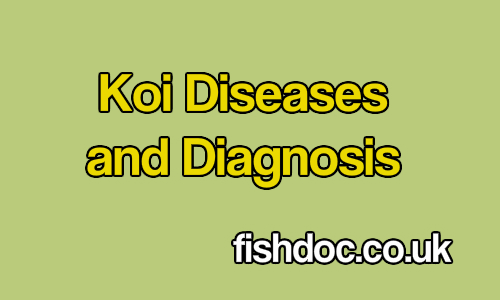Looking for reasons to die?
Koi do not spend their entire lives looking for reasons to die -in fact, it is quite difficult to kill them. The fact that health problems, disease and fatalities are so common in the hobby just confirms, in my opinion, that many common notions and practices – despite their failure – are still practiced with almost sacred reverence! I believe the most important aspect of successful koi-keeping is to recognize that it requires some degree of skill and knowledge, and we should be realistic about our individual capabilities, especially when it comes to stocking.
I believe that the headlong rush to get involved with real ‘hands-on’ fish-keeping lies at the root of many a health problem. The overwhelming majority of diseases can be prevented by good pond husbandry and, with few exceptions, the remainder can usually be resolved by early detection and taking corrective action.
Early detection is the key
The next, but equally important, stage is learning how to detect when something isn’t right, and what to do before it becomes a serious problem. A very common cause is a simple failure to spot or confront a problem soon enough – which of course means that it becomes harder to solve – and it often leads to other fish in the pond being affected. In many cases, owners seem blind to problems which may be obvious once pointed out!
My own theory is that while we spend a lot of time admiring our ‘living jewels’, we spend very little time ‘examining’ them. There is, of course, the added difficulty that we are often unsure about what we are supposed to be looking for.
Don’t underestimate the seriousness of a problem
Another common failing in hobbyist fish-keeping is the tendency to underestimate the seriousness of an injury or lesion. For instance, bacterial ulcerations are often attributed to the fish knocking or cutting themselves, and they are left to ‘get better’. In reality, the situation often worsens and spreads to others.. There is also a failure to appreciate that the true extent of the problem, which isn’t always apparent when the fish is in the water, and most injuries almost always looks worse when the fish is examined close up in a bowl.
I recall an occasion when I was asked to look at a cut on a koi’s head, which it had had for several weeks. When we put it in a bowl we saw that the fish had an ulcer that had gone through to the skull, as well as severe ulceration on the underside of the body. It was kinder to put the fish down than attempt to treat it!
How many are affected?
Determining the full extent of a condition, be it parasitic or bacterial has serious implications for the type and success of any treatment. It is often this failure to establish how many fish are affected, and the magnitude of the problem, that leads to stories of people losing large numbers of fish over a period of months.
When fish are lost in this way it gives the impression that a succession of fresh outbreaks has been caused (perhaps by some mystery superbug) when in fact all the deaths had the same original cause. Had the problem been diagnosed and treated originally the losses would probably not have occurred.
It is crucial for successful koi-keeping that we owners are aware of the condition of our fish, especially during spring and early summer. This means taking the time to have a critical look and carry out a systematic examination.
Understandably, our eye is drawn to their colours, pattern and graceful body shape – as well as their appealing faces – but it is all too easy to overlook the tell-tale signs on other parts of the body. Unfortunately, the charm and attraction of these living jewels can, in this instance, be to their undoing
Ill health is a fact of life for all animals and koi are no exception. However, our approach will have a major bearing on how successful we are in dealing with health problems when they occur.
Problems few and far between
Healthy fish living in optimum conditions are normally able to resist ill health and diseases. In this respect, they are no different to the family cat or dog, which generally only requires occasional veterinary attention. Unfortunately, as far as some owners are concerned, health problems and losses are an annual event that are accepted as inevitable, and much of the spring and summer can be spent treating sick fish or administering chemical treatments to the pond to combat problems. Success or expertise is judged on how many are ‘saved’ rather than on how many become ill or die!
A common approach to health problems is often founded on the ‘dartboard’ principle. This involves making an educated guess as to the nature of the problem and then applying a succession of chemical treatments until they either recover or die. However, it is fair to say that one of the main reasons why health problems get out of control is because of failure of many owners to adopt a systematic approach to health care and disease prevention.
If we think about the various steps involved in routine health care, irrespective of the species of animal, we can conclude that there are four basic steps that have to be followed in virtually all cases, namely:
- Observe
- To spot problems as soon as they are apparent and still minor
- Diagnose
- To determine exactly what the problem is
- Assist
- To determine and rectify the primary cause of the problem (e.g. poor water quality)
- Treat
- To treat the patient, having determined what the problem is and taken steps to eliminate it.
The real skill of koi-keeping is concerned with being able to identify potential problems at an early stage and taking steps to rectify the causes before a harsh treatment regime is required. Indeed, in many cases, when a problem is spotted early enough, no treatment at all is required, provided that the cause is rectified and optimum conditions are restored as soon as possible. Applying a treatment is the simplest thing to do and many fish-keepers seem to judge their competence purely on that!

